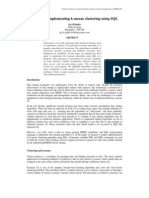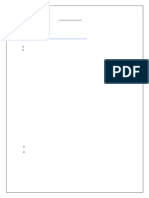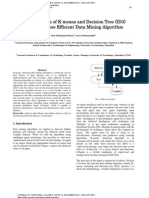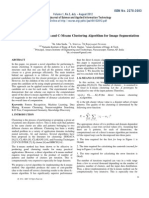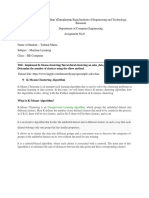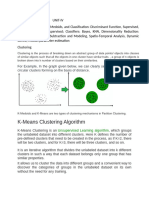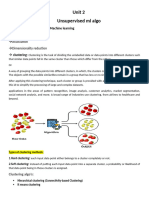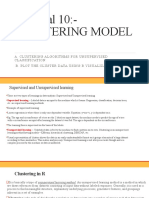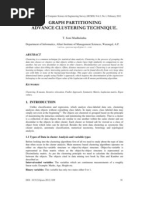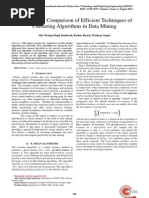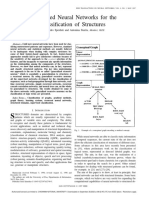Welcome To International Journal of Engineering Research and Development (IJERD)
Welcome To International Journal of Engineering Research and Development (IJERD)
Uploaded by
IJERDCopyright:
Available Formats
Welcome To International Journal of Engineering Research and Development (IJERD)
Welcome To International Journal of Engineering Research and Development (IJERD)
Uploaded by
IJERDOriginal Title
Copyright
Available Formats
Share this document
Did you find this document useful?
Is this content inappropriate?
Copyright:
Available Formats
Welcome To International Journal of Engineering Research and Development (IJERD)
Welcome To International Journal of Engineering Research and Development (IJERD)
Uploaded by
IJERDCopyright:
Available Formats
International Journal of Engineering Research and Development e-ISSN: 2278-067X, p-ISSN: 2278-800X, www.ijerd.
com Volume 5, Issue 12 (February 2013), PP. 24-28
Automated Clustering in K-Means Using Double Link Cluster Tree (DLCT)
R.Ranga Raj1, Dr.M.Punithavalli2,
Head of the Department Computer Science, Hindusthan College of Arts and Science Coimbatore 2 Director, Department of Computer Applications, Sri Ramakrishna Engineering College Coimbatore Abstract:- Clustering is the process of grouping related documents from the large collection of database. The mining of such related documents from the enormous database which are unlabelled is a challenging one. To overcome this problem, clustering is used to filter the unlabelled documents from the large collection of database. Clustering can be achieved by various algorithms that differ significantly in their notion and how to efficiently find them. The Standard K-Means algorithm is a well known data mining algorithm which can effectively cluster data in the database. K-mean is a simple algorithm that has been adapted to many problem domains. Hence by using k-mean, the initializations of number of clusters can be done through manually. In this research paper, a new technique DLCT (Double Link Cluster Tree) is merged with the enhanced K-Mean algorithm which helps to makes clustering in an efficient manner by without initializing of number of clusters and optimal clusters. The result of k-mean with DLCT, which allows automatic determination of number of clusters on any type of data such as documents, images etc. General Terms Effective Clustering Using DLCT Keywords:- Clustering, K-Means Enhanced Approach Algorithm, Double Link Cluster Tree (DLCT), unsupervised clustering.
1
I.
INTRODUCTION
Clustering algorithm can be categorized based on several cluster method. A cluster is a set of points such that a point in a cluster is closer to one or more other points in the cluster than to any point not in the cluster. A good clustering method will produce high quality cluster in which the intra cluster similarity is high and inter class similarity is low. For example, in an image related datasets it is difficult to identify how many clusters are available. Image clustering which is an important technology for processing image that has been actively researched for a long period of time. Recently the growth of interest in supervised method makes to improve the way of representing image sets. Image clustering is the high level description of image content. Nowadays the grayscale images are very important for analyzing image contents which has the application of satellite images to medical images. Such analysis becomes very complex. By using certain mathematical approach [1] the clustered grayscale images are determined with the optimal cluster number. The clustering process which separates the data into number of segments those are in the form of n-dimensional space. These segmented data uses a specific function which helps to model the data distribution [8]. Based on intra cluster and inter cluster distance measure in the mathematical approach which allows the number of clusters to be determined automatically. Cluster will be grow depend on the size of database. In other hand some existing subjects concentrates on reducing iteration in K-means method [2] during the clustering process so to obtain an optimized cluster output. These algorithm uses methods such as Genetic algorithm , PSO, Ant Colony Optimization (ACO) Using Genetics algorithm(GA) and PSO these are the optimization technique, to reduce the no of iteration. The new unsupervised k-means clustering algorithm [2] can be applied for the any type of datasets such as images, documents etc. This clustering process depends on the size of the database and concentrates on reducing iterations in K-Means method [1] to obtain an optimized cluster output.
II.
EXISTING WORK
Clustering can be achieved by various algorithms that differ significantly in their notion of what constitutes a cluster and how to efficiently find them. If the cluster analysis is done on image clustering, the growth of interest in unsupervised method makes to improve the way of representing image sets. There are
24
Automated Clusting in K-Means Using Double Link Cluster Tree (Dlct)
many clustering algorithms that can be performed on the image but by using k-means algorithm on image will obtain several segments. The k-mean clustering algorithm [2] will not provide the optimal cluster number and also makes initialization of number of clusters on the given data set. One way to overcome this problem is the mathematical approach [1], which is used to specify optimal cluster number with intra and inter cluster distance measure and finally allows automatic determination of number of clusters.
III.
K-MEANS ALGORITHM
Now, using K-Means clustering algorithm we can cluster an image to obtain segments. To run this algorithm, we need to provide the value of K which is nothing but the number of cluster centers. 3.1 Enhanced Approach The algorithm for Enhanced K-Means is as Follows Input: D={d1,d2,d3,..dn}//Set of n data points C={c1,c2,.ck}//Set of k clusters Output: A set of k clusters Steps: 1. Compute the distance of each data points di(1<=i<=n) to all the centroids cj(1<=j<=k) as d(di,cj). 2. For each data point di, find the closest centroid cj and assign di to cluster j. 3. Set cluster id[i]=j;//j:id of the closest cluster. 4. Set Nearest_Dist[i]=d(di,cj); 5. For each cluster j(1<=j<=k),recalculate the centroid; 6. Repeat; 7. for each data point di; 7.1 Compute its distance from the centroid of the present nearest cluster; 7.2 If this distance is less than or equal to the present nearest distance, the data point stay in this cluster; Else 7.2.1 For every centroid cj (1<=j<=k) Compute the distance d(di,cj); End for; 7.2.2 Assign the data point di to the cluster with the nearest centroid cj; 7.2.3 Set Cluster id[i]=j; 7.2.4 Set Nearest _Dist[i]=d(di,cj); Endfor; 8. For each cluster j(1<=j<=k); Recalculate the centroids; Untill the convergence criteria is met.
IV.
DLCT
DLCT is a Double Link Cluster tree which is used as the enhancement of Enhanced K-means algorithm. In certain dataset there will need for algorithm which can cluster the data without any initialization (i.e.) NO_OF_CLUSTERS.
Fig 1: The Diagrammatical representation of the DLCT DLCT is an algorithm, which works as a looping frame for Enhanced K-Means algorithm and makes Enhanced k-means algorithm to cluster the dataset several times.
25
Automated Clusting in K-Means Using Double Link Cluster Tree (Dlct)
The Algorithm for this method is shown below Step 1: Get the Database as input for the purpose of processing Let it be DB Step 2: Initialize the Level to 1 i.e., Level=1; Step 3: Find mean for the DB let it is A Step 4: By means of A, separation the DB Dataset is processed in to two groups let the First group be A1tmp which contains the value should be minimum to A i.e. less than A. Let the Second group be A2tmp should contain the value, less than A. Step 5: Now have two clusters A1tmp and A2tmp. Step 6: Like Step3 find mean for the A1tmp cluster and A2tmp Cluster Let it be B and C Step 7: Now initialize K-Means Algorithm with Initial Cluster center as B and C and No of Cluster would be 2 Step 8: Begin to cluster the Database DB. When K-means algorithm finished clustering the Database after certain Iterations the Outcome will be two clusters they are A1 and A2 Step 9: Increment the Level to 1 (Now Level =2;) (So at the level one, acquire 2 power 1 i.e 2 clusters at Level 2 and get 4 clusters vise versa) Step 10: Now at Level 2 the same steps or procedure were handled for cluster A1 and A2 (Steps from 4 to 9) Level inside our algorithm an algorithm Level 0 1 cluster (probably Original Dataset) Level 1 2 clusters Level 2 4 clusters Level 3 8 clusters and so on;
V.
PROPOSED WORK
In the traditional K-Means algorithm it has limitations of getting no of cluster centers [4] by means of its user. This makes K-Means difficult to use, where there is a unpredictable datasets are available. So to solve this problem we proposed a method named DLCT (Double Link Cluster Tree). In certain dataset there will need for algorithm which can cluster the data without any initialization. During the clustering processes are, 1. Sometimes the cluster centers of the tree node would be same. The algorithm will merge the two clusters which has unique cluster center 2. Due to data insufficiency some cluster will does not have any cluster element. So that cluster space was terminated. In the standard algorithm, the usage of K-Means algorithm [2] is allowed for clustering the datasets only one time, hence the numbers of clusters are given manually. The concept K-Means Enhanced Approach Algorithm with Double Link Cluster Tree (DLCT) focuses on clustering of documents and images in an efficient way by without initializing the number of clusters. In DLCT, the K-Means algorithm is used as library to process the clustering among all the Database types, images always contains the unpredictable amount of cluster in the Fig 2 and 3. It shows input image before clustering and output image after clustering.
Fig 2: Input image before clustering
Fig 3: Output Image after Clustering
26
Automated Clusting in K-Means Using Double Link Cluster Tree (Dlct)
Database Contains 200*200 Elements i.e. 40,000 items. Among them the cluster using DLCT is made as, Cluster1=30307 Elements Cluster2= 1300 Elements Cluster3 =865 Elements Cluster4=1997 Elements Cluster5= 3167 Elements Cluster6= 1621 Elements Cluster7=743 Elements For example, the Representation of Number of Clusters in the Character Database is shown in Fig 4 and Fig 5.
Fig 4: Number of Character Database
Fig 5: Number of Character Database
VI.
CONCLUSION
The clustering of datasets with Enhanced K-Mean algorithm [2] and DLCT helps to make clustering in an efficient way, by without initializing the number of clusters in an unpredictable database. The designing of Double Link Cluster Tree (DLCT) algorithm is done in such a way is solves the problems in previous unsupervised methods implemented. When comparing the proposed algorithm with various existing clustering algorithm, the analysis of clustering process results in the cluster centers. The proposed algorithm is also an automatic optimization process since the separation of the clusters is done each time for every level of the process. In which every cluster centers should have a difference of about 60% else those clusters that have less difference below 60% will be merged and considered as single cluster. This process will be handles to avoid minimum distanced cluster to be a separate clusters.
REFERENCES
[1]. A Novel Approach for Determination of Optimal Number of Cluster, Debashis Ganguly.Computer Science and Engineering,Department,Heritage Institute of Technology,Anandapur Kolkata 700107, India Improving the accuracy and efficiency of K-Mean Clustering Algorithm, by K.A. Abdul Nazeer, M.P. Sebastian. Proceeding of the world congress on Engineering 2009 vol I WCE 2009, July 1-3, 2009, London, U.K. Clustering Algorithms Based on Volume Criteria Raghu Krishnapuram and Jongwoo Kim IEEE TRANSACTIONS ON FUZZY SYSTEMS, VOL. 8, NO. 2, APRIL 2000. An Efficient k-Means Clustering Algorithm: Analysis and Implementation Tapas Kanungo, Senior Member, IEEE, David M. Mount, Member, IEEE, Nathan S. Netanyahu, Member, IEEE, Christine D. Piatko, Ruth Silverman, and Angela Y. Wu, Senior Member, IEEE VOL. 24, NO. 7, JULY 2002
[2].
[3]. [4].
27
Automated Clusting in K-Means Using Double Link Cluster Tree (Dlct)
[5]. A Comparison of Document Clustering Techniques, Michael Steinbach,George Karypis. Department of Computer Science University of Minnesota Technical Report #00-034 steinbac, karypis, kumar@cs.umn.edu Vipin Kumar. Document Image Segmentation Using Wavelet ScaleSpace Features Mausumi Acharyya and Malay K. Kundu, Senior Member, IEEE VOL. 12, NO. 12, DECEMBER 2002 Document Clustering in Correlation Similarity Measure Space Taiping Zhang; Yuan Yan Tang; Bin Fang; Yong Xiang Knowledge and Data Engineering, IEEE Transactions on Volume: 24 ,,2012 A review on image segmentation techniques,Pattern Recognition , N.R. Pal and S.K. Pal, vol. 26, pp. 1277-1294, 1993. A Modified K-Means Algorithm for Circular Invariant Clustering, Dimitrios Charalampidis, Member, IEEE VOL. 27, NO. 12, DECEMBER 2005 Randomized Clustering Forests for Image Classification Frank Moosmann, Student Member, IEEE, Eric Nowak, Student Member, IEEE, and Frederic Jurie, Member, IEEE Computer Society VOL. 30, NO. 9, SEPTEMBER 2008 Unsupervised Change Detection in Satellite Images Using Principal Component Analysis and k-Means Clustering, Turgay Celik, IEEE GEOSCIENCE VOL. 6, NO. 4, OCTOBER 2009
[6]. [7]. [8]. [9]. [10].
[11].
28
You might also like
- Image Segmentation Using K Mean AlgorithmDocument5 pagesImage Segmentation Using K Mean AlgorithmYonsNo ratings yet
- Biomimicry in ArchitectureDocument10 pagesBiomimicry in Architecturerodolfo barbosaNo ratings yet
- 8.2 Extraction of Part Feature Information From CAD ModelDocument6 pages8.2 Extraction of Part Feature Information From CAD ModelMega GamesNo ratings yet
- SQLDM - Implementing K-Means Clustering Using SQL: Jay B.SimhaDocument5 pagesSQLDM - Implementing K-Means Clustering Using SQL: Jay B.SimhaMoh Ali MNo ratings yet
- JETIR1503025Document4 pagesJETIR1503025EdwardNo ratings yet
- Ijert Ijert: Enhanced Clustering Algorithm For Classification of DatasetsDocument8 pagesIjert Ijert: Enhanced Clustering Algorithm For Classification of DatasetsPrianca KayasthaNo ratings yet
- A Novel Approach For Data Clustering Using Improved K-Means Algorithm PDFDocument6 pagesA Novel Approach For Data Clustering Using Improved K-Means Algorithm PDFNinad SamelNo ratings yet
- INTRO TO ML ASSDocument3 pagesINTRO TO ML ASSgayukalai67No ratings yet
- DynamicclusteringDocument6 pagesDynamicclusteringkasun prabhathNo ratings yet
- ML - Unit - 2Document13 pagesML - Unit - 2Dr D S Naga Malleswara RaoNo ratings yet
- Text Analytics Unit-3Document11 pagesText Analytics Unit-3aathyukthas.ai20001No ratings yet
- Assignment 4 ADocument15 pagesAssignment 4 Asahilmukund.awasarkarNo ratings yet
- Ijettcs 2014 04 25 123Document5 pagesIjettcs 2014 04 25 123International Journal of Application or Innovation in Engineering & ManagementNo ratings yet
- Experiment No 07: Mihir Patel Teit 2Document5 pagesExperiment No 07: Mihir Patel Teit 2MIHIR PATELNo ratings yet
- Attack Detection by Clustering and Classification Approach: Ms. Priyanka J. Pathak, Asst. Prof. Snehlata S. DongreDocument4 pagesAttack Detection by Clustering and Classification Approach: Ms. Priyanka J. Pathak, Asst. Prof. Snehlata S. DongreIjarcsee JournalNo ratings yet
- Fundamentals of Data Science Unit 3Document15 pagesFundamentals of Data Science Unit 3rakshithadahnuNo ratings yet
- An Integration of K-Means and Decision Tree (ID3) Towards A More Efficient Data Mining AlgorithmDocument7 pagesAn Integration of K-Means and Decision Tree (ID3) Towards A More Efficient Data Mining AlgorithmJournal of ComputingNo ratings yet
- Unit - 4 DMDocument24 pagesUnit - 4 DMmintoNo ratings yet
- Unit 4 Descriptive ModelingDocument18 pagesUnit 4 Descriptive ModelingAtul GaurNo ratings yet
- Unit 4Document4 pagesUnit 4adityapawar1865No ratings yet
- I Jsa It 04132012Document4 pagesI Jsa It 04132012WARSE JournalsNo ratings yet
- Assignment 5Document3 pagesAssignment 5Pujan PatelNo ratings yet
- BDU - Document - Dominant Color in An Image Using KDocument46 pagesBDU - Document - Dominant Color in An Image Using Kthalaaskar55No ratings yet
- K-Means ClusteringDocument5 pagesK-Means ClusteringManiNo ratings yet
- The International Journal of Engineering and Science (The IJES)Document4 pagesThe International Journal of Engineering and Science (The IJES)theijesNo ratings yet
- Assignment 6 MLDocument4 pagesAssignment 6 MLMansi TodmalNo ratings yet
- An Enhanced Clustering Algorithm To Analyze Spatial Data: Dr. Mahesh Kumar, Mr. Sachin YadavDocument3 pagesAn Enhanced Clustering Algorithm To Analyze Spatial Data: Dr. Mahesh Kumar, Mr. Sachin YadaverpublicationNo ratings yet
- ML Unit 2 NotesDocument14 pagesML Unit 2 Notesskmirajulislam181No ratings yet
- ML Application in Signal Processing and Communication EngineeringDocument27 pagesML Application in Signal Processing and Communication Engineeringaniruddh nainNo ratings yet
- An Improved K-Means Algorithm Based On Mapreduce and Grid: Li Ma, Lei Gu, Bo Li, Yue Ma and Jin WangDocument12 pagesAn Improved K-Means Algorithm Based On Mapreduce and Grid: Li Ma, Lei Gu, Bo Li, Yue Ma and Jin WangjefferyleclercNo ratings yet
- CV UNIT 4Document60 pagesCV UNIT 4jayalakshmi.mca staffNo ratings yet
- K MeanDocument7 pagesK MeanDeergha TiwariNo ratings yet
- Mazumder DeepVAT A Self-Supervised Technique For Cluster Assessment in Image Datasets ICCVW 2023 PaperDocument9 pagesMazumder DeepVAT A Self-Supervised Technique For Cluster Assessment in Image Datasets ICCVW 2023 PaperNadou SheNo ratings yet
- A Density Clustering Based On OutlierDocument6 pagesA Density Clustering Based On OutliermirosehNo ratings yet
- unsupervised learningDocument23 pagesunsupervised learningshaukeenkha3606No ratings yet
- Unit4 DatascienceDocument43 pagesUnit4 DatasciencedrsaranyarcwNo ratings yet
- Unit 5 - Cluster AnalysisDocument14 pagesUnit 5 - Cluster Analysiseskpg066No ratings yet
- Unit-4 (2)Document29 pagesUnit-4 (2)Krishna RaoNo ratings yet
- Iterative Improved K-Means ClusterinDocument5 pagesIterative Improved K-Means Clusterinmadhuridalal1012No ratings yet
- Ijret 110306027Document4 pagesIjret 110306027International Journal of Research in Engineering and TechnologyNo ratings yet
- Research On K-Means Clustering Algorithm An Improved K-Means Clustering AlgorithmDocument5 pagesResearch On K-Means Clustering Algorithm An Improved K-Means Clustering AlgorithmSomu NaskarNo ratings yet
- Unsupervised Learning - Clustering Cheatsheet - CodecademyDocument5 pagesUnsupervised Learning - Clustering Cheatsheet - CodecademyImane LoukiliNo ratings yet
- Chinninti Venkata Assessment Machine LearningDocument11 pagesChinninti Venkata Assessment Machine Learningsriharsha jinniNo ratings yet
- An Efficient Incremental Clustering AlgorithmDocument3 pagesAn Efficient Incremental Clustering AlgorithmWorld of Computer Science and Information Technology JournalNo ratings yet
- Clustering in RDocument12 pagesClustering in RRenukaNo ratings yet
- Image Annotations Using Machine Learning and FeaturesDocument5 pagesImage Annotations Using Machine Learning and FeaturesIceNFirE GamingNo ratings yet
- K Means Clustering - Experiment 12Document3 pagesK Means Clustering - Experiment 12Prateek VermaNo ratings yet
- A Fast K-Means Implementation Using CoresetsDocument10 pagesA Fast K-Means Implementation Using CoresetsHiinoNo ratings yet
- Storage Technologies: Digital Assignment 1Document16 pagesStorage Technologies: Digital Assignment 1Yash PawarNo ratings yet
- ML UNIT 4 SirDocument42 pagesML UNIT 4 Sirsampathmandru18No ratings yet
- K-Means_Clustering_ReportDocument2 pagesK-Means_Clustering_ReportVishnu Prasad PrasadNo ratings yet
- An Initial Seed Selection AlgorithmDocument11 pagesAn Initial Seed Selection Algorithmhamzarash090No ratings yet
- ST-DBSCAN: An Algorithm For Clustering Spatial-Temporal DataDocument14 pagesST-DBSCAN: An Algorithm For Clustering Spatial-Temporal Datajose puma chavezNo ratings yet
- ML-12Document19 pagesML-12adnanriaz2024No ratings yet
- ML extendedDocument25 pagesML extendedanchitbansal11No ratings yet
- Graph Partitioning Advance Clustering TechniqueDocument14 pagesGraph Partitioning Advance Clustering TechniqueijcsesNo ratings yet
- Aiml - 06 - 28Document4 pagesAiml - 06 - 28darshil shahNo ratings yet
- Efficient Data Clustering With Link ApproachDocument8 pagesEfficient Data Clustering With Link ApproachseventhsensegroupNo ratings yet
- CLUSTERINGDocument11 pagesCLUSTERINGSwarnlataNo ratings yet
- Normalization Based K Means Clustering AlgorithmDocument5 pagesNormalization Based K Means Clustering AlgorithmAntonio D'agataNo ratings yet
- Analysis&Comparisonof Efficient TechniquesofDocument5 pagesAnalysis&Comparisonof Efficient TechniquesofasthaNo ratings yet
- Router 1X3 - RTL Design and VerificationDocument10 pagesRouter 1X3 - RTL Design and VerificationIJERDNo ratings yet
- High Phase Order Transmission System: "A Solution For Electrical Power Transmission in Deregulated Environment"Document9 pagesHigh Phase Order Transmission System: "A Solution For Electrical Power Transmission in Deregulated Environment"IJERDNo ratings yet
- Investigations On Properties of Light Weight Cinder Aggregate ConcreteDocument10 pagesInvestigations On Properties of Light Weight Cinder Aggregate ConcreteIJERDNo ratings yet
- Emotion Detection From TextDocument12 pagesEmotion Detection From TextIJERDNo ratings yet
- Nonlinear OptimisationDocument11 pagesNonlinear OptimisationPoojith L. UNo ratings yet
- Errors in Numerical Analysis PDFDocument2 pagesErrors in Numerical Analysis PDFAngela100% (1)
- Machine Learning EbookDocument63 pagesMachine Learning EbookGhost Rider100% (1)
- FFT VHDL CodeDocument4 pagesFFT VHDL CodeDeepanwita SarNo ratings yet
- Slide 9 Shop Floor Control: Arif Rahman, ST MTDocument60 pagesSlide 9 Shop Floor Control: Arif Rahman, ST MTOni LarasatiNo ratings yet
- AgentsDocument37 pagesAgentsSana MateenNo ratings yet
- Ben-Naim Entropy Order2011 PDFDocument3 pagesBen-Naim Entropy Order2011 PDFJohnFedericoMartinezMuñozNo ratings yet
- Lecture 3-Modern CryptographyDocument58 pagesLecture 3-Modern Cryptographyr.arshadr12No ratings yet
- Operation ResearchDocument23 pagesOperation ResearchTahera ParvinNo ratings yet
- Model Exit Exam JUDocument13 pagesModel Exit Exam JUabagidi430No ratings yet
- CS407 Neural Computation: Neural Networks Based On Competition. Lecturer: A/Prof. M. BennamounDocument62 pagesCS407 Neural Computation: Neural Networks Based On Competition. Lecturer: A/Prof. M. BennamounIlham YacineNo ratings yet
- IB AA HL Test Paper - Probability and StatisticsDocument3 pagesIB AA HL Test Paper - Probability and StatisticsBHAGWAN SINGHNo ratings yet
- Rolf Harren and Rob Van Stee - Absolute Approximation Ratios For Packing Rectangles Into BinsDocument19 pagesRolf Harren and Rob Van Stee - Absolute Approximation Ratios For Packing Rectangles Into BinsMnaomNo ratings yet
- Machine Learning For Complex and Unmanned Systems: February 2024Document2 pagesMachine Learning For Complex and Unmanned Systems: February 2024Dương Trần Mỹ LinhNo ratings yet
- Filter KalmanDocument4 pagesFilter KalmanjojojoNo ratings yet
- Arham Foundation'S Arham School and Junior College XI Science Computer Science - 1 Assignment - 50 MarksDocument2 pagesArham Foundation'S Arham School and Junior College XI Science Computer Science - 1 Assignment - 50 MarksarcNo ratings yet
- MEC522 PBL ArduinoDC MotorEncoder Close LoopDocument4 pagesMEC522 PBL ArduinoDC MotorEncoder Close LoopeimanNo ratings yet
- Protection Coordination in Networks DistributionDocument1 pageProtection Coordination in Networks DistributionChân Gà NướngNo ratings yet
- First Law of ThermodynamicsDocument13 pagesFirst Law of ThermodynamicsPrince TalaNo ratings yet
- Shannon FanonDocument3 pagesShannon FanonTARUN SINGH SVNITNo ratings yet
- Chapter 1 - Algorithm Analysis ConceptDocument15 pagesChapter 1 - Algorithm Analysis ConceptGetaneh AwokeNo ratings yet
- Supervised Neural Networks For The Classification of StructuresDocument22 pagesSupervised Neural Networks For The Classification of StructuresAbubakar IsahNo ratings yet
- 05 Linear Algebra and Machine LearningDocument24 pages05 Linear Algebra and Machine LearningLily Cruz0% (1)
- DigitalDocument3 pagesDigitalHKNo ratings yet
- CCN Lab Manual VtuDocument21 pagesCCN Lab Manual VtuDr Narayana Swamy Ramaiah50% (2)
- Difference Between Machine Learning and Deep LearningDocument5 pagesDifference Between Machine Learning and Deep Learningbablusinghaniya047No ratings yet
- A New Anti Swing Control of Overhead CranesDocument6 pagesA New Anti Swing Control of Overhead CranesEFRAIN ESTEBANNo ratings yet
- MRK - Spring 2024 - MTH624Document5 pagesMRK - Spring 2024 - MTH624kiran malikNo ratings yet
- 10th Polynomials NotesDocument27 pages10th Polynomials NotesVinay Chitikela100% (8)



